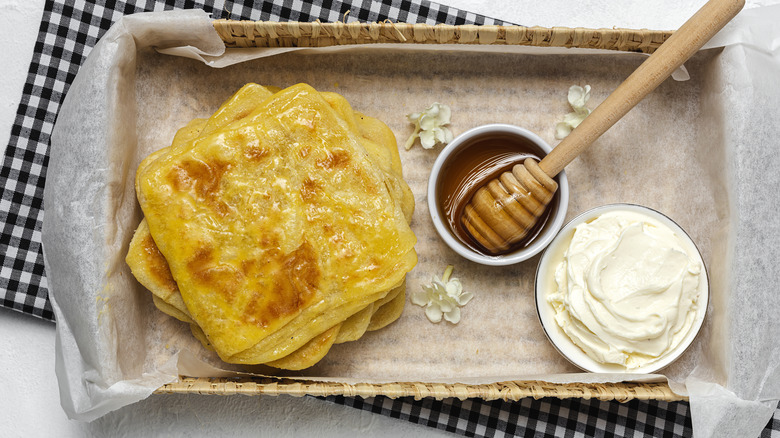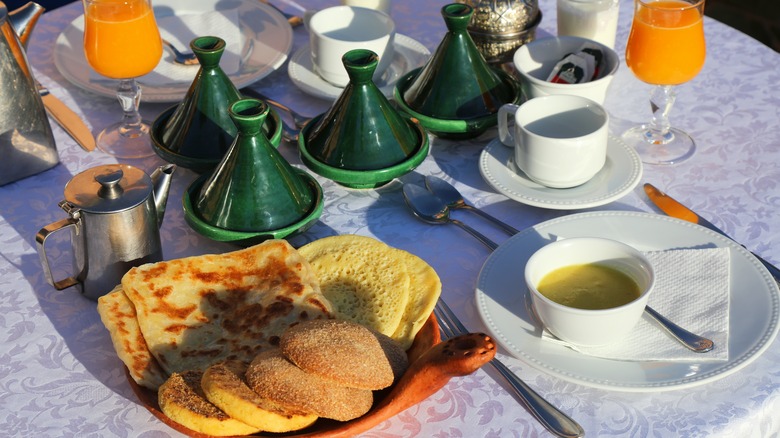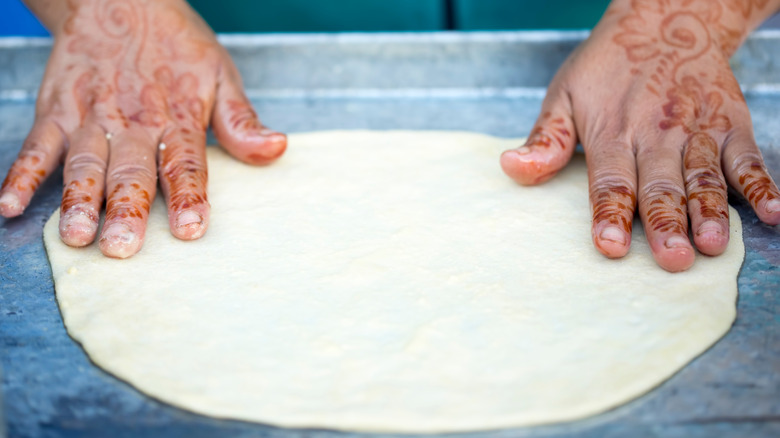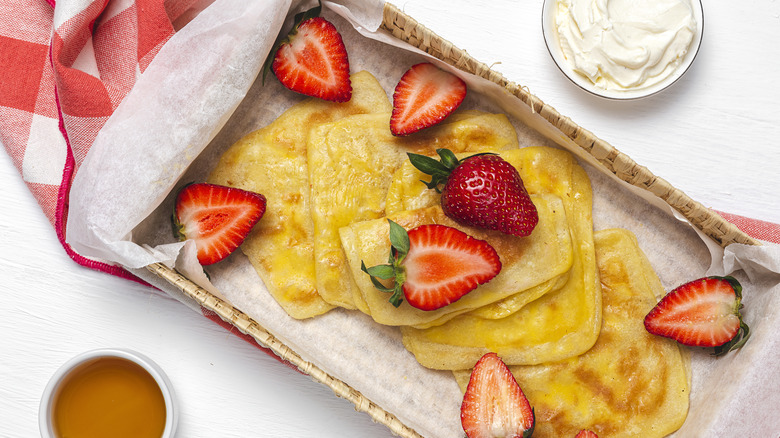Msemen Is The Moroccan-Style Crepe Your Morning Needs
Pancakes and waffles are American breakfast classics. They can be seen served on the tables of virtually every family comedy TV show before the kids head off to school, and they're equally as ubiquitous in real life. While you may not be whipping up pancake mix on every average weekday morning, when you're in the mood for a big breakfast, they'll almost certainly make an appearance — whether that's on your table or at your local IHOP. But that doesn't mean the sweet side of the breakfast menu should be limited to pancakes or waffles. When the basics start to get boring, your morning needs msemen.
Also known as msemmen or rghaif in Arabic, msemen is a Moroccan-style crepe, only it's richer and flakier. The dough is folded like a puff pastry, flattened, and pan-fried to create delicate layers of flaky crepe paired with your choice of sweet or savory filling. They're very similar to Moroccan meloui, or malawi, but they're shaped differently — squarer rather than rolled into a coil. Msemen are often referred to as "Moroccan pancakes" — although some hand that title to beghrir, another Moroccan bread with a softer, spongier batter — because they're a treat as common on the Moroccan breakfast table as pancakes and waffles are in the United States. And if you're looking to spice up your own breakfast, msemen is well worth a try.
Msemen in Moroccan culture
While msemen is credited to Morocco, it can be found all across the Maghreb region — from Tunisia to Algeria. There, you'll easily find it for sale at bakeries or as street food in the many souks that are famous in the region. In Marrakesh specifically, you'll be able to find women stretching and folding the dough by hand in and around the famous Jemaa al Fna Square. There's also La Sqala, a restaurant situated in Casablanca's Old Medina, that frequently tops recommendation lists for its traditional cuisine and brunch menu, which you can guarantee features msemen along with many other Moroccan delicacies. Served with hot mint tea or orange juice, cheese, and honey-butter syrup, msemen is the perfect excuse to stop, sit down, and take in the culture.
Savory msemen — the style also commonly referred to as "rghaif" — are also a staple of Morocco's street food, and they come loaded with onions, ground beef or lamb, and fresh parsley and cilantro. They're typically found in the souks of Moroccan cities like Fes, Essaouira, and Marrakesh, where you'll spot locals roaming the stalls in the evenings for quick bites before heading back home to prepare dinner.
Whether sweet or savory, msemen is undoubtedly a must-try street food when visiting Morocco. However, many Moroccan people prefer to make their own at home for breakfast or as an afternoon snack with tea, along with spreads like butter, cheese, sweet jam, or honey.
How msemen is made
Msemen can be tricky at first, but once you get it, you'll be able to prepare them as quickly as pancakes — or at least, that's the goal. It starts out easy: Simply get your ingredients together for the batter and set aside some counter space for yourself. Then, start mixing the semolina powder, flour, sugar, salt, and yeast until you get a somewhat sticky ball of dough. So far, so easy — but this is where things get a bit more complicated. You're going to divide the dough into smaller pieces and start folding.
You might doubt yourself at first, but trust that your msemen are going to get prettier as you go — and, just like Moroccan chebakia, they'll be well worth their prep time. Start by flattening each section of dough and spreading them with oil and butter. Then, sprinkle with a bit of extra semolina powder and fold both sides of the dough in and over one another length-wise — and then again cross-wise — to form a small, square pocket.
Once folded, the dough should rest for about 10-15 minutes before you roll them out and start frying. They're best served warm, but if you do have extra, know that they freeze wonderfully. Without eggs, they're very allergen friendly, and they can easily be made dairy-free by substituting the butter with oil or using plant-based butter. However, it's not recommended to make msemen gluten-free because their texture relies on the elasticity of the flour while folding.
Serving msemen
When it comes to serving msemen, you can take inspiration from any of your usual flaky, buttery breakfast pastries. In Morocco, they're usually served with cheese, fruit jams, butter, or honey, so it might be fun to put out a serving of each so you can try them all. You could also go the route of a cheese danish and try cream cheese on your warm msemen, especially if it's paired with fresh fruit — whether that's blueberries, raspberries, or strawberries. In the summer, grilled peaches or apricots would make it even more of a treat, and they'd go great with the butter and honey syrup that msemen are traditionally served with. However, you shouldn't be afraid to venture away from the traditional.
Like any other crepe, msemen can be served with everyone's favorite hazelnut spread, Nutella, along with your choice of bananas or berries. You could also get experimental with your own fruit syrups or jams by utilizing whatever's in season. Of course, there's also the possibility of going the savory route, for which cheese, meat, onions, and any variety of vegetables are always an option. You could even take inspiration from your favorite flatbread-style pizzas by adding everything from pepperoni and cheese to pesto and mozzarella. Regardless of which route you choose, the flaky texture of the msemen is sure to be life-changing — and you may never go back to your breakfast table without it.



